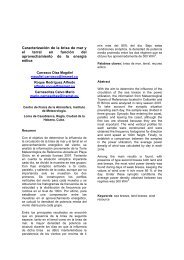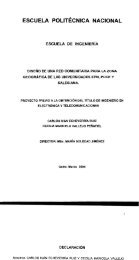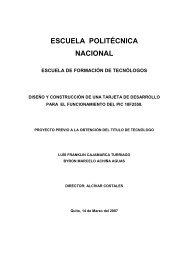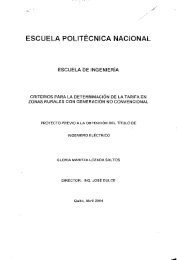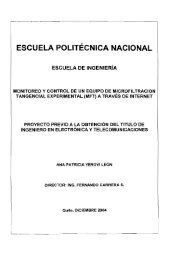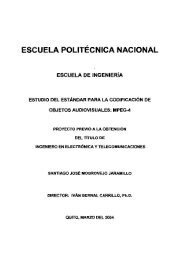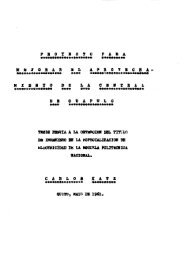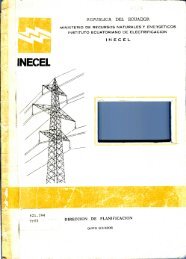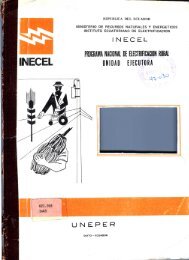Tesis previa a la obtención del Título de Ingeniero en Electrónica y ...
Tesis previa a la obtención del Título de Ingeniero en Electrónica y ...
Tesis previa a la obtención del Título de Ingeniero en Electrónica y ...
You also want an ePaper? Increase the reach of your titles
YUMPU automatically turns print PDFs into web optimized ePapers that Google loves.
lecomm<strong>en</strong>dation H.242<br />
[ Introduction<br />
SYSTEM FOR ESTABLISHING COMMÜNICATION<br />
BETWEEN AUDIOVISUAL TERMINALS<br />
ÜSING DIGITAL CHANNELS ÜP TO 2 Mbit/s<br />
(G<strong>en</strong>ova, 1990; revised at Helsinki, 1993)<br />
^his Recomm<strong>en</strong>dation should be associated with Recomm<strong>en</strong>dations G.725 (System aspects for the use of the 7 kHz<br />
udio co<strong>de</strong>e within 64 kbit/s), H.221 (Frame structure for 64 to 1920 kbít/s channels in audiovisual teleservices)<br />
nd H.230 (Frame-synchronous control and indication signáis for audiovisual systems).<br />
L number of applications utilizing narrow (3 kHz) and wi<strong>de</strong>band (7 kHz) speech together with vi<strong>de</strong>o and/or data have<br />
ic<strong>en</strong> i<strong>de</strong>ntified, including high quality telephony, audio and vi<strong>de</strong>oconfer<strong>en</strong>cing (with or without various kinds of<br />
elematic aids), audíographic confer<strong>en</strong>cing and so on. More applications will undoubtedly emerge in the future.<br />
'o proví<strong>de</strong> these services, a scheme ís recomm<strong>en</strong><strong>de</strong>d ín which a channel accommodates speech, and optionally vi<strong>de</strong>o<br />
nd/or data at several rates, in a number of díffer<strong>en</strong>t mo<strong>de</strong>s. Signalling procedures are required to establish a<br />
ompatible mo<strong>de</strong> upon cali set-up, to switch betwe<strong>en</strong> mo<strong>de</strong>s during a cali and to allow for cali transfer.<br />
lome services wíll require only a single channel, which could according to the procedures in this Recomm<strong>en</strong>dation be<br />
! (64 kbit/s), H0 (384 kbit/s), Hn (1536 kbit/s) or H12 (1920 kbit/s). Other services will require the establishm<strong>en</strong>t of<br />
tvo or more connections providíng B or HQ channels: in such cases the first established is called hereafter the initial<br />
hannel while the others are called addítíonal channels, Unless otherwise specified, all refer<strong>en</strong>ces to frame alignm<strong>en</strong>t<br />
ignal (FAS), bit rate allocation signal (BAS) and service channel (SC) refer to the initial channel or, in the case of a<br />
ígher-or<strong>de</strong>r channel, to the time-slot No. 1 of this channel.<br />
Lll audio and audiovisual termináis using G.722 audio coding and/or G.711 speech coding or other standardizad audio<br />
odings at lower bit rales should be compatible to permit connection betwe<strong>en</strong> any two termináis. This implies that a<br />
ommon mo<strong>de</strong> of operation has to be established for the cali. The initial mo<strong>de</strong> might be the only one used during a cali<br />
r, altematively, switching to another mo<strong>de</strong> can occur as nee<strong>de</strong>d <strong>de</strong>p<strong>en</strong>ding on the capabilities of the termináis. Thus,<br />
or these termináis an in-channel procedure for dynamic mo<strong>de</strong> switching is required,<br />
'he followíng c<strong>la</strong>uses <strong>de</strong>velop these consi<strong>de</strong>rations and <strong>de</strong>scribe recomm<strong>en</strong><strong>de</strong>d in-channel procedures.<br />
Terminal capabilities<br />
'he procedures in this Recomm<strong>en</strong>dation are mt<strong>en</strong><strong>de</strong>d to <strong>en</strong>sure that only those signáis are transmitted which can be<br />
;ceived and appropriately treated by the remote terminal, without ambiguity. This requíres that the capabilities of each<br />
¡rminal to receive and <strong>de</strong>co<strong>de</strong> be known to the other terminal. Some capabilities are <strong>de</strong>fined with a hierarchical<br />
Eructure; a terminal with capability valué N is th<strong>en</strong> also capable of all lower valúes. Where there Ís no hierarchy, th<strong>en</strong><br />
¡vo or more co<strong>de</strong>s of the same type may have to be transmitted in successive frames.<br />
'he following subc<strong>la</strong>uses <strong>de</strong>fine audio, ví<strong>de</strong>o, transfer rate, and data rate capabilities of a terminal. It Ís not necessary<br />
<strong>la</strong>t a terminal un<strong>de</strong>rstand or store all íncoming capabilities. Those which are not un<strong>de</strong>rstood, or which cannot be used<br />
secause the terminal has no means to transmít corresponding information), can be ignored.



